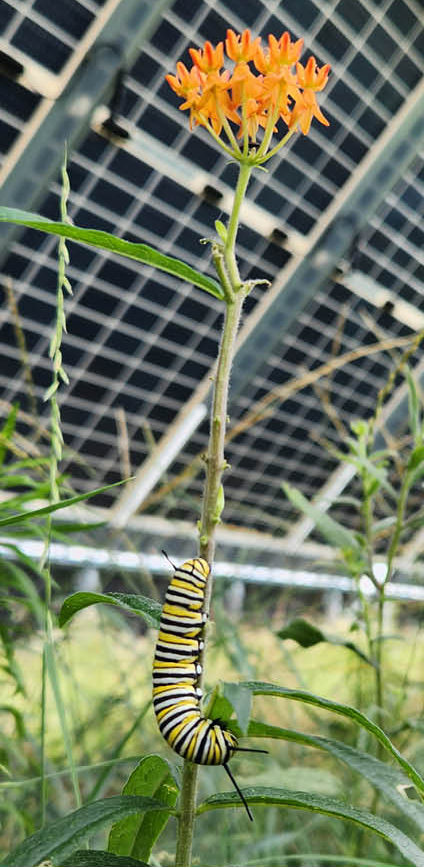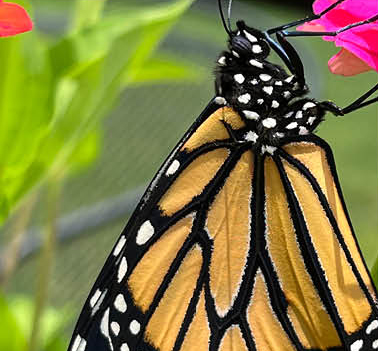Environmental
Natural resources and biodiversity
MGE takes steps to protect our natural resources. This means doing our part to help improve waterways, preserve the natural beauty of our communities and protect wildlife habitats.
Fund for Lake Michigan/Salt Wise Strategic Development Grant
Lake Michigan’s water is critical to Wisconsin’s future. MGE supports the Fund for Lake Michigan (the Fund), which helps sustain the lake for those who depend on it. Among its projects, the Fund supports the Wisconsin Salt Wise Strategic Development Grant. It provides funding to help communities and regions of the state protect our waterways by becoming salt certified.
In winter, many companies and individuals use salt to combat icy sidewalks and roads; however, excess salt flows into our waterways, negatively impacting water quality. One teaspoon of salt pollutes five gallons of water, and once in the water, salt cannot be removed. Additionally, chloride, a chemical in salt, is toxic to small aquatic life.
Oftentimes, more salt than is needed to fully melt ice on parking lots and sidewalks is applied. That means some of the salt put down is washed away. Salt certification provided through the grant trains consumers how to calculate the amount of salt needed for an area without a lot of waste.
The Wisconsin Salt Wise Partnership spearheaded salt-reduction efforts in Dane County. Madison launched the state’s first salt certification program several years ago. MGE works with a local certified salt applicator for snow removal at our facilities.

Combating the decline of monarchs
Monarch butterfly populations in the United States have seen substantial declines in their population the last few decades. In 2022, monarchs were officially designated as endangered by the International Union for Conservation of Nature.
One of the biggest impacts on the monarch population is the loss of habitat for breeding, migrating and overwintering. The monarch butterfly needs habitat for both its caterpillar and adult populations. Adult monarchs feed on the nectar from many flowering plants throughout the growing season, but they breed only in areas where milkweed is found. Milkweed is critical for their survival. Monarchs lay their eggs on milkweed, and their caterpillars are dependent on milkweed as a food source during their development. Milkweed is native to Wisconsin and can be found almost anywhere wildflowers grow throughout the state.
MGE providing habitat: MGE has been increasing our habitat for monarchs and pollinators at our facilities. We have planted native plants, including flowering natives, on all our MGE-owned and MGE-operated solar generation sites.
We’ve worked with our vegetation management consultants and asked for input from experts at the Wisconsin Department of Natural Resources and the Public Service Commission of Wisconsin to review several of our plant mixes to ensure they are viable in our climate, monarch-friendly and pollinator-friendly. We are actively managing our sites so that native plantings establish and invasive and undesirable woody plants do not overtake our native plantings.
At three of our MGE-owned and MGE-operated solar sites, representing more than half of MGE’s owned and operated solar acreage, our native seed mixes were planted to support the monarch’s life cycle from egg to caterpillar and to adult. This was accomplished by planting several types of milkweed and native plants that will flower throughout the monarch season in Wisconsin. Our partners at our jointly owned solar generation sites also have planted monarch-friendly and pollinator-friendly natives.
Our habitat conservation efforts at these solar sites are a good fit since we have space around and even under the solar arrays that would otherwise be turfgrass. We continue to take inventory of what habitat we have planted and planned, and we’re looking for opportunities to expand where it makes sense.
A protection agreement: Since monarchs migrate, they need to be able to find suitable habitat throughout their migration pathway. Increased development, fragmented habitat and intentional removal of milkweed all contribute to an overall reduction in habitat. One way the U.S. Fish & Wildlife Service is working to address this is through the development of a voluntary agreement with utility companies and departments of transportation in the states where monarchs are found.

The voluntary Monarch Candidate Conservation Agreement with Assurances (Monarch CCAA) is designed to increase monarch habitat throughout their migratory range using transportation and utility properties, such as rights-of-way and generation facilities, to plant monarch-friendly milkweed and flowering plants. The agreement allows utilities flexibility for further growth and protection against future monarch regulatory obligations in exchange for agreeing to maintain and/or create monarch habitat on a certain percentage of their properties. MGE continues to review our internal commitments and habitat inventory to determine whether the Monarch CCAA is a good fit for our monarch and pollinator commitments.
The Monarch CCAA also supports other pollinators, such as native bees. Land dedicated to the Monarch CCAA will have flowering plants from spring to fall, which many native bee populations need to thrive.
26 years as Tree Line USA utility
MGE recently marked 26 years of being named a Tree Line USA utility. The distinction recognizes our efforts to protect community trees and enhance urban forests. The Tree Line USA program recognizes best practices in public and private utility arboriculture, demonstrating how trees and utilities can co-exist for the benefit of communities and residents. The
Arbor Day Foundation collaborates with the National Association of State Foresters on this initiative. MGE’s Forestry team and other employees across the company collaborate to help ensure we meet all the necessary requirements to be designated a Tree Line USA utility.
Falcon restoration
Since 2009, peregrine falcons have nested at our Blount Generating Station in downtown Madison. Man-made nesting boxes at power plants have proven to be ideal homes for the birds of prey, which are an endangered species in Wisconsin. The use of DDT pesticide beginning in the 1940s eradicated them.
Falcons were reintroduced to Wisconsin in the 1980s, and while they are listed as endangered in Wisconsin, they have made a slow, steady comeback due to statewide efforts and nesting boxes like the one at Blount Generating Station. The original nesting box at the plant was installed in 1999. It was built by an MGE employee and his son. In fall 2018, due to renovations at the power plant, employees built a new falcon box and moved it to a new location at the plant, which the falcons began using for nesting in 2019.
The falcon chicks born in 2023 have names inspired by iconic Wisconsin foods and voted on by MGE employees. Cheese Curdis, a female, was named for the little chunks of white or orange cheese that haven’t gone through the aging process. Made famous as a Wisconsin delicacy, this squeaky cheese can be found on the menu at many Wisconsin establishments. Cream Puff, a female, was named for the famous French pastry Wisconsinites have grown to love and celebrate every year at the Wisconsin State Fair.
MGE has seen 55 falcons hatch at Blount Generating Station since 2009 when they began nesting at the plant. Falcon expert Greg Septon visits the power plant every spring for our naming ceremony during which the chicks also are banded for tracking throughout their lifetimes. For more information on MGE’s falcons, visit
mge.com/falcons.
MGE is proud to support the ongoing recovery of these raptors through our nesting box and support from the MGE Foundation for Hoo’s Woods Raptor Center, a local nonprofit dedicated to the rehabilitation of birds of prey and the preservation of their ecosystems.
Erosion control
We are committed to implementing proper erosion control methods at all work sites. This minimizes the likelihood of soil being washed out of a site. We track permits and inspections and have dedicated staff who review new regulations, field techniques and technologies to ensure we manage our erosion-control strategies effectively.
Protecting waterways
In 2022, we updated our environmental emergency response plans for facilities with high risk to waterways, human health and sensitive environmental features. MGE’s Environmental Affairs staff reviewed the plans for accuracy and improvement regarding the potential for release of materials, oil or chemicals to wetland, waterbody or other environmentally sensitive areas from operations, bulk storage or construction. Employee training at facilities with the highest risk also was completed.
Stormwater management
Pollutants transported in stormwater are harmful to lakes, rivers, wetlands and waterways. MGE implements measures to protect our water bodies. For example, MGE’s downtown parking lot has a stormwater filtration system. This system cleans stormwater before it drains into nearby Lake Monona and is effective in reducing pollutants such as petroleum compounds, sediment and phosphorus.
Phosphorus reduction in local lakes
Another way MGE supports clean lakes is through Yahara WINS. This collaborative water cleanup effort began as a pilot and expanded to a 20-year program to reduce phosphorus in our watershed. MGE supports this project through financial support from the MGE Foundation and through service on its technical advisory board, the Yahara Watershed Improvement Network Group. A collaborative approach pools the resources and expertise of community partners. It employs the strategy of watershed adaptive management in which all sources of phosphorus pollution are addressed together to meet water quality goals.
Yahara WINS is exceeding expectations for modeled phosphorus reductions and is on track to meet its 20-year project goals. In 2022, the program reported more than 50,500 pounds of phosphorus reduced, which was greater than its goal of 43,076 pounds.
Solar power at corporate office
Nearly 450 solar panels on our corporate office in Madison help to power the facility. The array, along with 52 panels in our visitor parking lot, represents another step in our ongoing path toward greater sustainability throughout our operations. In addition, MGE’s 2,000-square-foot office building in Prairie du Chien, Wis., has 20 rooftop solar panels.
Search by Environmental area of interest
Decarbonization goals and strategies
Clean energy
Energy efficiency and conservation
Electrification of transportation
Modern grid
Sustainability benchmarking and performance
Transparency and disclosure